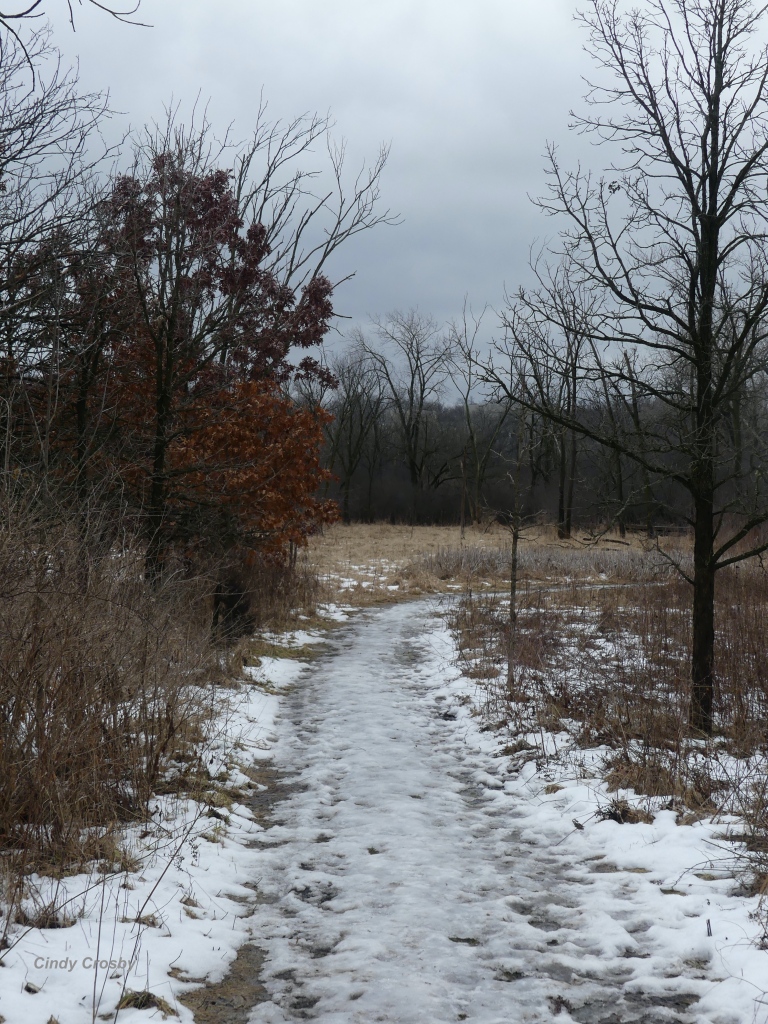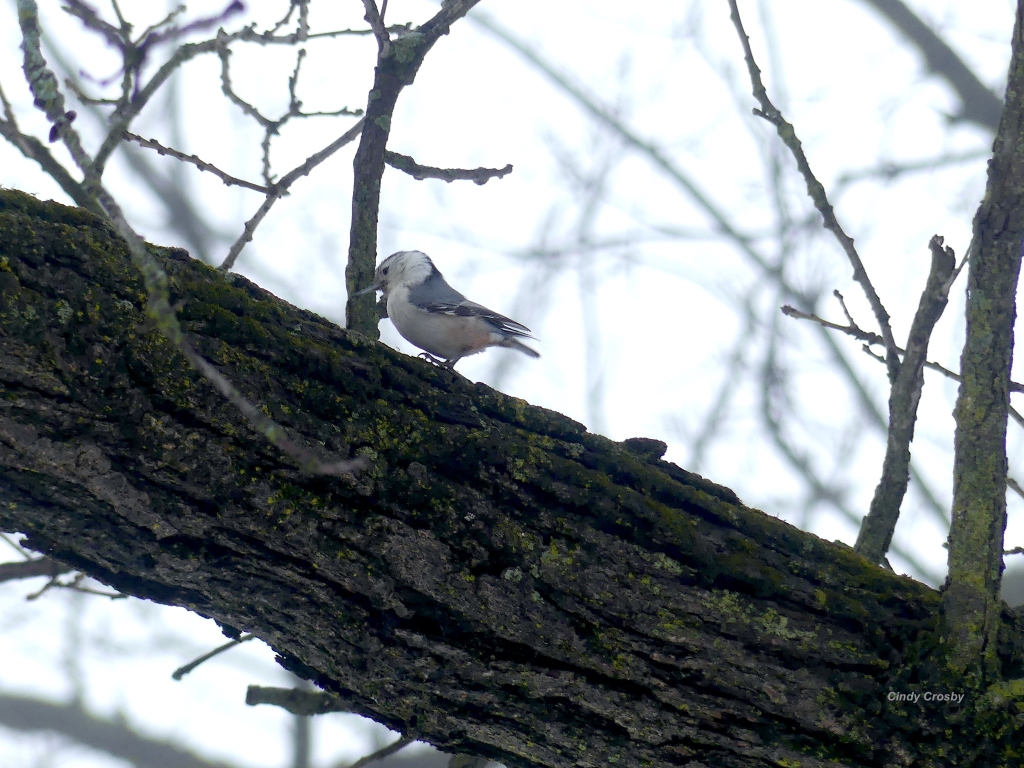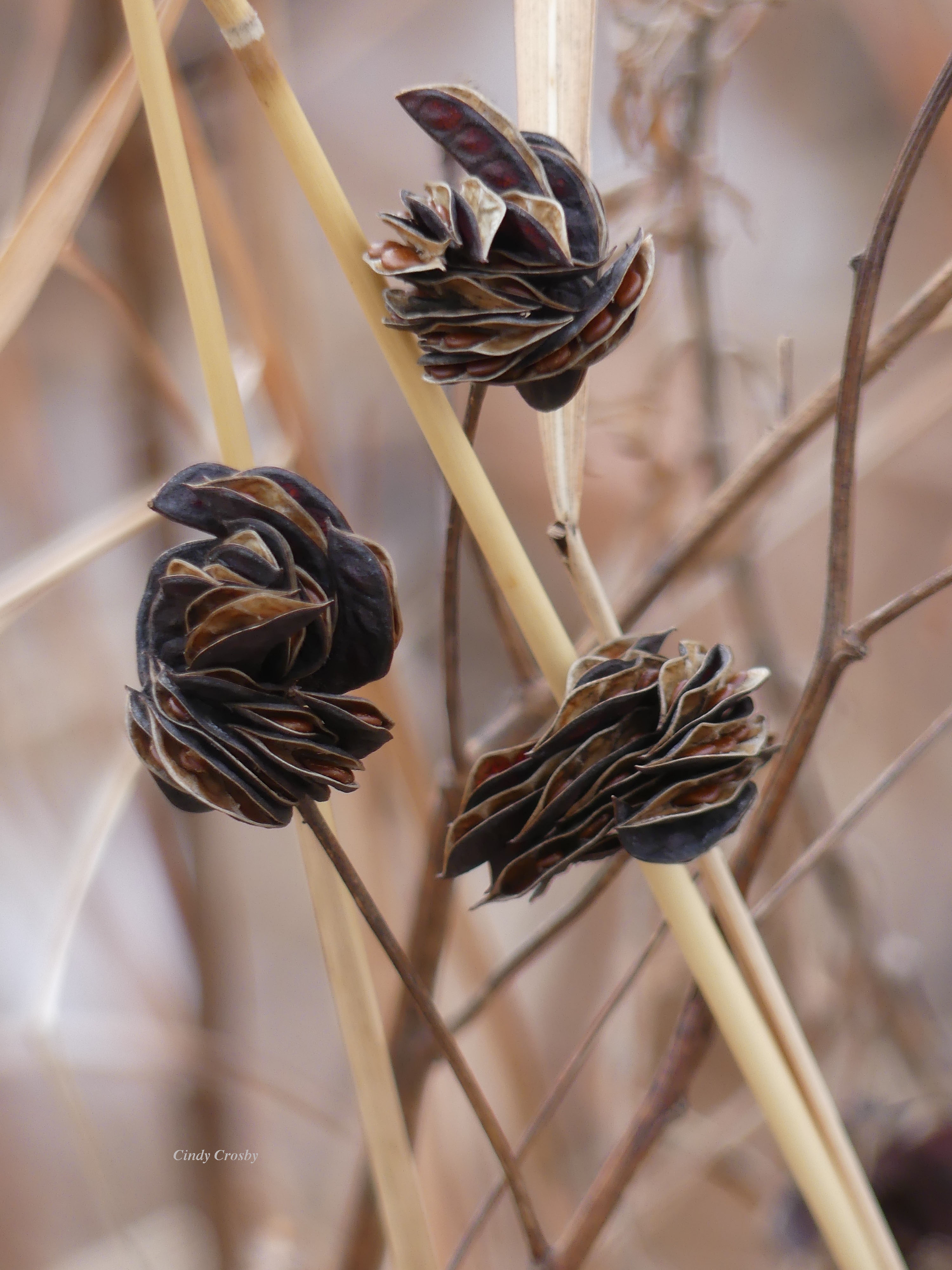“The…world becomes even more beautiful the closer you look. All it takes is attention and knowing how to look.” – –Robin Wall Kimmerer
****
What stories does a feather have to tell?

Jeff and I are hiking Belmont Prairie; our last hike, it turns out, for a while. As we follow the shallow stream to where it disappears…

…the feather comes into focus at my feet. It looks unreal, with its polka-dotted edge and its graceful arch. Such a lovely silken feather, lying in the mud. I wonder. Who did it belong to? Later, I text a photo of it to a birder friend. Downy or hairy woodpecker, he tells me, most likely. I wonder at the stories this feather could tell.
Once, this feather embodied flight. It provided warmth and waterproofing. Now, it is grounded. Soon, it will disappear into the prairie soil and be unremembered. Except by me.
I’ve felt sad this week. A deep grief. There has been so much loss.

My usual remedy for sadness and uncertainty is to go to “my” prairies and walk, journal, and think. But the options for hiking have narrowed this week. My prairie stewardship is on hold because of our shelter in place orders. One prairie where I lead a regular work group is closed. Another, requires extensive travel, and I’m no longer comfortable with the idea of driving 90 miles each way. Scientific research and monitoring is halted until the end of the month. Or longer.

And now, a walk on Belmont Prairie—not far down the road from where I live—is becoming an adventure of the sort I don’t want. Narrow trails. Too many hikers. Each of us is painfully aware of not getting too close to the other.

Today, instead of enjoying my walk here, I feel tense. A hiker appears in front of me, wearing earbuds. I step deep into the tallgrass and we smile at each other as he passes. Too close. Another arrives on a bike. Seeing me, she veers away. A bridge requires single file passage. Because there has been no prescribed burn due to the shelter in place, it’s difficult to see someone until we almost run into each other.

This, I come to understand as I walk, will be my last hike here for a while. Looks like our backyard prairie may be the best place for Jeff and me during the next few weeks.

Later, I try to sit with my grief over yet another loss. The loss of beloved places. I try not to ignore my feelings. Not set them aside. But I let myself feel this grief for a few moments. It’s slightly terrifying. My old ways of coping by “going for a hike on the prairie” are no longer available. I realize I have a choice. I can be angry at what’s closed off to me. I can be depressed at what’s been taken away. Or…
I can be grateful for what I do have.

I don’t want you to think I’m being Polyanna-ish about this. I’ve been mad this week, and I’ve been sad. I mourned when my stewardship work was put on hold; and cried again when my other prairie was closed to visitation, science work, and stewardship. These were good decisions by good organizations—made for the health of people. But tough for those of us who love a particular place. Each loss hurt—to not see the emerging pasque flowers bud and bloom, to miss the first crinkled shoots of wood betony pushing through the prairie soil. To not watch the killdeer return. The emerald scrub brushes of newly-emerging prairie dropseed will be long and lush before I’m hiking those trails again.
 The solace of these familiar and beloved places is no longer available to me. I can choose to continue to be unhappy about this. Or I can take account of what I do have.
The solace of these familiar and beloved places is no longer available to me. I can choose to continue to be unhappy about this. Or I can take account of what I do have.
What I do have is a backyard. I have my walks. ‘Round and ’round and ’round the block we go each morning, Jeff and I, soaking up the surprisingly diverse natural world of our neighborhood. Grassy lawns full of common wild violets, our Illinois state wildflower.

Lawns–some full of diversity, others chemical-ed into monocultured submission. Some are power-edged sharply along sidewalks with volcano-mulched trees, aggressively brought to obedience.
Others are softer, more natural. An eastern-cottontail munches clover in one yard against a backdrop of daffodils. We hear loud cries, and look up as sandhill cranes fly over, somewhere above the bare silver maple limbs etched across blue skies and altocumulus clouds. Like stained glass windows to another world we can only dimly perceive.

In the cracks of the driveways and the sidewalks blooms a tiny flower. I’m not sure if it’s early Whitlow grass or common chickweed. My iNaturalist app isn’t sure of the ID either. I count the petals, and when I return home, consult my field guides. Chickweed has five petals, deeply cleft—which look like ten at a glance, my guide tells me. Early Whitlow grass, I read, has four petals, deeply cleft, looking as if they are eight petals.

Chickweed it is!
As I walk, I think about the backyard that will be my “hiking spot” for the foreseeable future. When we moved in, and I met our neighbor Gerould Wilhelm, co-author of Flora of the Chicago Region, I asked his advice. What was the best way to learn native plants of our area? He told me, “Key out one plant in your backyard a day, Cindy. By the time a year has passed, you’ll know 365 plants.” It was great advice, and I took it—for a while. Then I quit. Now might be the time to put my backyard ID into more regular practice.

I walk through my yard, looking. Over there in the prairie patch—new growth of rattlesnake master and shooting star. And —oh no—buckthorn! Garlic mustard has infiltrated the prairie patch, pond, and garden beds. While my attention was elsewhere doing my stewardship work removing invasives the past few years, these bad-boy plants crept into my yard.

As I slosh through the wetter areas of the yard, I’m reminded that our house is on the downslope of three other homes in our suburban subdivision. Water, water, everywhere. Our raised beds have helped us solve the problem of growing vegetables in the “swamp.” My little hand-dug pond, sited at the lowest point of the yard, holds some of the water and provides great habitat for western chorus frogs, dragonflies and damselflies, and marsh marigolds which came into bloom a few days ago on the perimeter.

One of the outflows of all this water is the mosses that accumulate. But what kinds of mosses? With mosses on my mind, I ordered a “Common Mosses of the Northeast and Appalachians,” recommended by Dr. Andrew Hipp. (If you haven’t checked out his thoughtful and intelligent woodland blog, give it a look!) Mosses are…. difficult. I begin with a simple moss that appears in the cracks of our neighborhood sidewalks and backyard patio.

I follow with a photo of a moss from my Belmont hike.

Hmmm. It’s a good book. But I can see identifying mosses is going to be a challenge. There’s no instant gratification, and it’s a lot more difficult than ID’ing the chickweed. But, it’s a potentially absorbing activity that I can look forward to over the next few weeks in my backyard. I like having something new to focus on that’s available to me.
After a while, I put the mosses book aside and sit in a patch of sunshine. A cardinal pours out his heart to his lady-love. Goldfinches chitter and chat, then swarm the thistle feeder, resplendent in their brightening plumage.

It’s good to feel a connection with my backyard. A kinship with the natural world. ID’ing mosses—feeling the warmth of the sun, listening to birdsong—reminds me that I’m not alone. I needed that reminder right now. You, too?
We’re in this together.

Keep looking for the light. It’s there.

Keep watching for signs of hope. Pay attention.

Hope and light are all around us. We only need to look.
*****
The opening quote is from Robin Wall Kimmerer’s (1953-) Gathering Moss: A Natural and Cultural History of Mosses (2003). She is best known for Braiding Sweetgrass, but her earlier book is still my favorite.
****
All photos copyright Cindy Crosby (top to bottom): downy or hairy woodpecker feather, Belmont Prairie Nature Preserve, Downer’s Grove, IL; stream trickling to an end at Belmont Prairie Nature Preserve, Downer’s Grove, IL; gray-headed coneflower (Ratibida pinnata), Belmont Prairie Nature Preserve, Downer’s Grove, IL; trail by Belmont Prairie Nature Preserve, Downer’s Grove, IL; raccoon (Procyon lotor) tracks, Belmont Prairie Nature Preserve, Downer’s Grove, IL; footbridge over the stream through Belmont Prairie Nature Preserve, Downer’s Grove, IL; Jeff hikes Belmont Prairie Nature Preserve, Downer’s Grove, IL; Canada wild rye (Elymus canadensis); Belmont Prairie Nature Preserve, Downer’s Grove, IL; common blue violet (Viola sororia sororia); silver maple (Acer saccharinum) with sky and clouds, author’s neighborhood, Glen Ellyn, IL; common chickweed (Stellaria media), author’s neighborhood, Glen Ellyn, IL; bee balm (Monarda fistulosa), invasive Queen Anne’s lace (Daucus carota) and native rattlesnake master (Eryngium yuccifolium), Belmont Prairie Nature Preserve, Downer’s Grove, IL; marsh marigold (Caltha palustris), author’s backyard pond, Glen Ellyn, IL; unknown moss (but hopefully not for long!), author’s neighborhood, Glen Ellyn, IL; unknown moss (but hopefully not for long!); Belmont Prairie Nature Preserve, Downer’s Grove, IL; goldfinches (Spinus tristis) at the feeder, author’s backyard, Glen Ellyn, IL; rattlesnake master (Eryngium yuccifolium), Belmont Prairie Nature Preserve, Downer’s Grove, IL; sun halo over author’s backyard prairie patch, Glen Ellyn, IL: unknown rock on my neighborhood walk, Glen Ellyn, IL.
Thanks to John Heneghan for help with the bird feather ID.
*****
Cindy’s Speaking and Classes
Cindy’s classes have moved online! For updates on classes and events, please go to http://www.cindycrosby.com. The next “Tallgrass Prairie Ecology” class online begins in early May through The Morton Arboretum. See more information and registration here. The website is updated to reflect current conditions. A free spring wildflower webinar is also in the works! Watch for a link on Cindy’s website, coming soon.
Want more prairie? Follow Cindy on Facebook, Twitter (@phrelanzer) and Instagram (@phrelanzer). Or enjoy some virtual trips to the prairie through reading Tallgrass Conversations: In Search of the Prairie Spirit and The Tallgrass Prairie: An Introduction.

























 The solace of these familiar and beloved places is no longer available to me. I can choose to continue to be unhappy about this. Or I can take account of what I do have.
The solace of these familiar and beloved places is no longer available to me. I can choose to continue to be unhappy about this. Or I can take account of what I do have.














































































